- Home
- Blog
- Agile & Scrum
- What is Extreme Programming - XP Practices

Anyone who uses a laptop or mobile device on a regular basis must be familiar with what programmers do. Since companies and customers are continually looking for new software, developers create new products, while programmers oversee the code required to make the software work.
The concept of extreme programming is gaining much more acceptance in the software world since it makes the coding process efficient and effective. This blog serves as the introduction to Extreme Programming (XP) that the market will need. However, anyone interested in discovering what this concept can offer them should read this blog.
| What is Extreme Programming -Table of Contents |
What Is Extreme Programming (XP)?
Extreme Programming (XP) is an agile software development framework that aims to produce higher-quality software with changing requirements. Furthermore, XP is most explicit in terms of the right engineering practices for software development.
XP is built upon values, principles, and practices that allow small to mid-sized teams to produce high-quality software and adapt to evolving and changing requirements.
XP was introduced by Ken Beck in the 90s with the objective to find new approaches to writing high-quality software fastly and to adapt to changing customers’ needs.
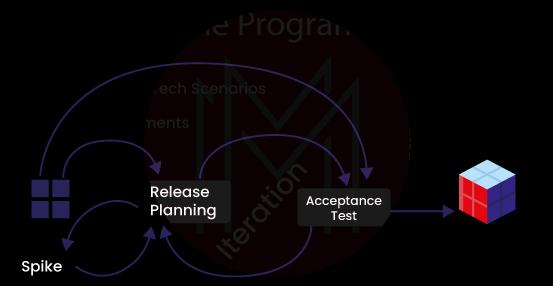
To get a clear understanding of these practices, we’ll start by describing how XP’s work and the roles engaged in the process.
| If you want to enrich your career and become a professional in Agile, then visit Mindmajix - a global online training platform: "Agile Online Training" This course will help you to achieve excellence in this domain. |
How Does Extreme Programming Work?
In contrast to other approaches, XP is very opinionated in engineering practices. In addition to practices, XP is based on values and principles.
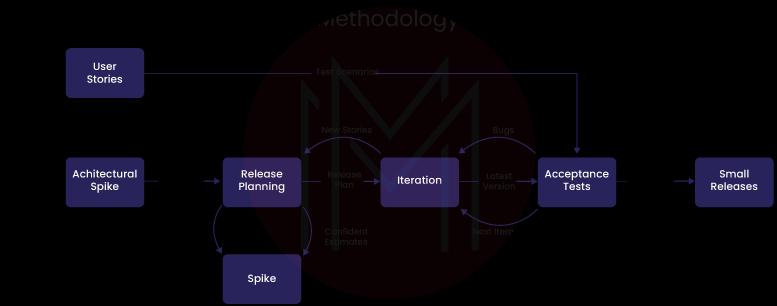
Values: For teams, values provide direction. They serve as a high-level "north star" to direct your choices. Values, however, are too nebulous and vague to provide precise instruction. Saying that you appreciate the communication, for instance, can have a variety of effects.
Practices: In some respects, practices are accountable to values. They define the specifics of what to do clearly, and practically. Teams can hold one another accountable to the ideals through practices. For example, the use of Informative Workspaces encourages open and straightforward communication.
Principles: They are industry-specific guidelines that bridge the gap between ideals and practices.
Next, let’s understand XP values, principles, and practices in-depth, and how they work together to create extreme programming.
| Related Article: Agile Interview Questions and Answers |
What Are the Values, Principles, and Practices of Extreme Programming?
#1. XP Values
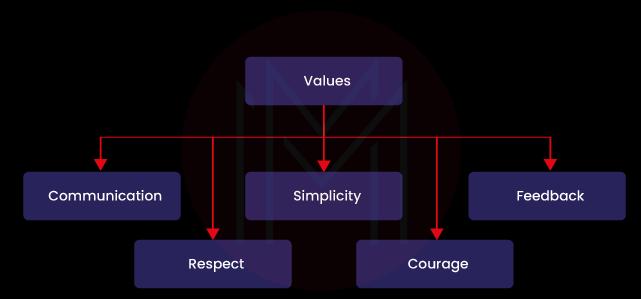
Values provide direction to the team in making high-level decisions.
- Communication: It’s essential for good teamwork, since sharing knowledge is impossible without it.
- Simplicity: By developing efficient, straightforward code that performs as intended, developers can save time and effort. In the end, the value of the product is increased by the simpler code.
- Feedback: For team members who frequently produce software, early, consistent feedback is important since it enables them to adapt as the project develops and takes different turns. It is simpler to implement modifications when programmers are informed of the need for adjustments earlier rather than later (and less painful).
- Respect: Everyone on the team takes pride in their work and contributes.
- Courage: To admit you're incorrect and that your plan needs to be changed because it didn't work takes courage. It takes real courage, to be honest, and you need the honesty to give reasonable estimations, even if stakeholders don't like the truth.
#2. XP Principles
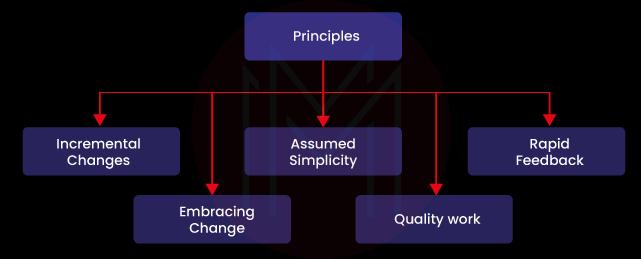
Unlike values, principles are more grounded, practical, and concrete ideas. XP principles specify what teams must do in detail and give team members a way to hold one another responsible for upholding the principles. These are the five guidelines:
- Fast feedback: This principle means receiving input quickly, acting on it immediately, and not delaying action.
- Assumed simplicity: Team members must focus their efforts on the work that is of the highest priority and ignore tasks that are redundant or unneeded. Ensure simplicity.
- Incremental changes: It's better to make minor adjustments gradually than to let them build up and deal with them all at once.
- Embrace change: Speaking of modifications, programmers should support any requests from clients to alter the final product and plan how to do so.
- Produce high-quality work: A cohesive team will invariably produce a superior product that they can be proud of.
#3. XP Practices
Initially, there were twelve practices of extreme programming, but they have been honed and reduced through time. This list of practices is the most current.
- Sit together: This idea refers to the importance of communication. The ideal way to communicate is usually face-to-face. Thus, the team should be seated together in a space without barriers or separators.
- The whole team: The entire team is made up of a cross-functional group of individuals, each of whom plays a vital part in advancing the development of the product. Everybody participates and collaborates on a daily basis.
- Informative workspace: Since the team should sit together, the workspace should support this. There must be some privacy protections, though.
- Energized work: Team members should take the necessary precautions to maintain a concentrated state of mind and body. These measures include avoiding distractions, limiting workload, maintaining good health, and showing respect for your coworkers.
- Pair programming: Based on the premise that you need two pairs of eyes to notice faults, every production software is written by two persons working together on the same computer.
- Stories: Through the use of relatable examples, stories explain the purposes of the product to buyers and users. These tales also aid programmers and developers in organizing their projects.
- Weekly cycle: Weekly cycles are like iterations in programming. The team meets at the beginning of the week to go through the current status. The client chooses the stories that will be completed that week. The group chooses how to approach them.
- Quarterly cycle: Quarterly cycles are similar to releases in that they maintain the specific work done during each weekly cycle in line with the overall project. The customer explains the team's general strategy in relation to the features that must be completed within a quarter.
- Slack: Include a few low-priority tasks or stories in the weekly and yearly cycles that can be abandoned if the team lags behind on the more important ones.
- Ten-minute build: The ultimate goal of the ten-minute build is to run all tests and automatically construct the entire system in ten minutes. This procedure encourages the team to depend more on build process automation.
- Continuous integration: Test new code changes as soon as they are incorporated into the main codebase, assisting the team in identifying mistakes and integration problems as they arise.
- Incremental design: When delivering specific features, programmers should go deeply into the minutiae of a particular area of the design after doing a little preliminary work to understand the proper view of the system design. This approach saves money on revisions while providing programmers with the most recent data they need to make design decisions.
- Test-first programming: With this method, programmers create code first, then write tests, and last execute tests.
-
- Create an automated test that fails.
- Run an automated test that fails.
- Create code to ensure the test passes.
- Run a test
- Repeat
Extreme Programming Advantages
The benefits of extreme programming are as follows:
- Slipped schedules
- Project cancellation
- Increase in the costs due to modifications
- Post delivery defects
- Business changes
- Staff turnover
Slipped schedules − and achievable development cycles ensure timely deliveries.
Project cancellation − Focus on continuous customer involvement ensures transparency with the customer and immediate resolution of any issues.
Increase in the costs due to modifications - Extensive and ongoing testing makes sure the changes do not break the existing functionality. A running working system always ensures sufficient time for accommodating changes such that the current operations are not affected.
Production and post-delivery defects - Emphasis is on − the unit tests to detect and fix the defects early.
Business changes − Changes are considered to be inevitable and are accommodated at any point in time.
Staff turnover − Intensive team collaboration ensures enthusiasm and goodwill. The cohesion of multi-disciplines fosters team spirit.
XP Key Roles and Responsibilities
Even an experienced extreme programming team shouldn't rely on fixed roles, new teams can profit from them by keeping members inside their designated areas of responsibility until the method is no longer required. The four most typical XP roles are as follows:
- The Client: An actual customer should be there to prioritize user stories, respond to inquiries, and participate in acceptance testing. The client should appoint a representative if none is available.
- The programmers: Programmers calculate the amount of time needed to complete tasks and stories, build automated tests, and put client tales into practice.
- The coach: Not every team needs a leader, but occasionally this position is necessary to make sure that everyone adheres to the procedures regularly enough for them to become habits and to prevent team members from reverting to previous routines.
- The Tracker: As its name suggests, the tracker monitors the team's metrics for progress, including spotting roadblocks and coming up with workarounds.
How To Get Started With XP?
Having technical knowledge and XP practices can be difficult. For programmers who aren't accustomed to them, some of the techniques may seem strange.
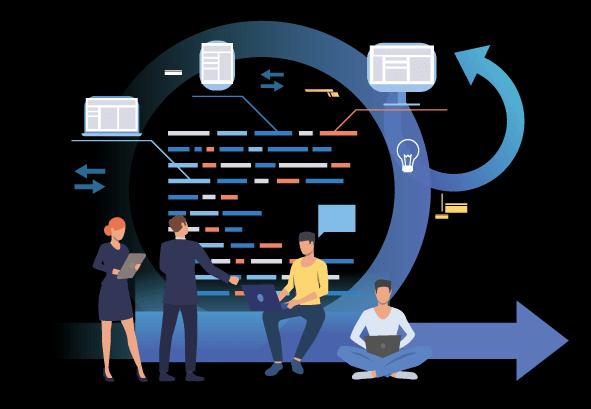
Teams can start with XP by implementing one core practice at a time. Determine your next objective to help you decide where to start. Select a method that supports that objective.
Start with pair programming and TDD, for instance, if your team needs to develop a sense of trust in the code and other team members. Adopt communal code ownership if you want to get rid of the danger brought on by relying too heavily on particular team members.
| Related Article: TDD VS BDD |
Extreme Programming FAQs
1. What is Extreme Programming vs scrum?
Scrum is a methodology that helps teams develop complex projects in an adaptive way. Scrum doesn't set any guidelines for how developers must accomplish their work. While XP focuses on best programming practices.
Furthermore, programming is undoubtedly at the core of XP. On the other hand, Scrum may be utilized on any project that benefits from an iterative approach.
XP allows modifications to its components. Teams are free to modify the tasks to meet their specific requirements. On the other hand, the Scrum Guide is categorical that "implementing some portions of Scrum is possible, but the result is not Scrum."
Scrum is a framework that must be completed with work-related methodologies and practices.
Therefore, using XP and Scrum together is feasible and highly recommended.
2. How is XP different from agile?
Extreme Programming involves the client in the software development process, just like other Agile methodologies do. It does not, however, use any intermediaries to connect the team and the customer, unlike other Agile methodologies. On XP projects, all of the work is divided into smaller portions.
3. Who introduced Extreme Programming?
In the 1990s, Kent Black tried to create a more efficient method of software development while handling a project at DaimlerChrysler. This was the initial emergence of extreme programming (XP). His innovative approach eventually earned the name "Extreme Programming Methodology," and it was effective.
4. What are the important characteristics of Extreme Programming?
The main characteristics of extreme programming (XP) include:
- Dynamically varying software needs.
- Using a small, extended development team.
- Using technology that makes functional and automated tests.
5. What are the phases of Extreme Programming?
The extreme programming lifecycle is divided into 6 phases
- Exploration
- Planning
- Iterations to release
- Production
- Maintenance
- Death.
Conclusion
The popularity of agility concepts is rising as they prove to be effective. Extreme programming offers a lot of useful methods that can assist with software development, even though it is not the most common methodology. These techniques are worth considering for usage in your projects.
 On-Job Support Service
On-Job Support Service
Online Work Support for your on-job roles.

Our work-support plans provide precise options as per your project tasks. Whether you are a newbie or an experienced professional seeking assistance in completing project tasks, we are here with the following plans to meet your custom needs:
- Pay Per Hour
- Pay Per Week
- Monthly
| Name | Dates | |
|---|---|---|
| Agile Training | Nov 29 to Dec 14 | View Details |
| Agile Training | Dec 02 to Dec 17 | View Details |
| Agile Training | Dec 06 to Dec 21 | View Details |
| Agile Training | Dec 09 to Dec 24 | View Details |

Madhuri is a Senior Content Creator at MindMajix. She has written about a range of different topics on various technologies, which include, Splunk, Tensorflow, Selenium, and CEH. She spends most of her time researching on technology, and startups. Connect with her via LinkedIn and Twitter .













